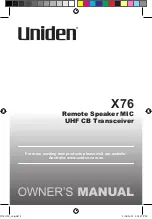
For product support please see www.digitalyacht.co.uk
Page 7
AIT2000 Installation & Operation Manual
VERSION 1.01
2
ABOUT YOUR AIS CLASS B TRANSPONDER
2.1
About AIS
The marine Automatic Identification System (AIS) is a location and vessel information reporting system. It allows
vessels equipped with AIS to automatically and dynamically share and regularly update their position, speed,
course and other information such as vessel identity with similarly equipped vessels. Position is derived from the
Global Positioning System (GPS) and communication between vessels is by Very High Frequency (VHF) digital
transmissions.
There are a number of types of AIS device as follows:
Class A transponders
These are similar to class B transponders, but are designed to be fitted to large vessels such as cargo ships and
large passenger vessels. Class A transponders transmit at a higher VHF signal power than class B transponders and
therefore can be received by more distant vessels. They also transmit Class A transponders are mandatory on all
vessels over 300 gross tonnes on international voyages and certain types of passenger vessels under SOLAS regu-
lations.
Class B transponders
Similar to class A transponders in many ways, but are normally lower cost due to the less stringent performance
requirements. Class B transponders transmit at a lower power and at a lower reporting rate than class A tran-
sponders.
AIS base stations
AIS base stations are used by Vessel Traffic Systems to monitor and control the transmissions of AIS transponders.
Aids to Navigation (AtoN) transponders
AtoNs are transponders mounted on buoys or other hazards to shipping which transmit details of their location to
the surrounding vessels.
AIS receivers
AIS receivers will generally receive transmissions from class A transponders, class B transponders, AtoNs and AIS
base stations but do not transmit any information about the vessel on which they are installed.
This product is an AIS Class B transponder.
2.2
Static and dynamic vessel data
There are two categories of information transmitted by an AIS transponder: static and dynamic data.
The vessel's dynamic data, which includes location, speed over ground (SOG) and course over ground (COG), is
calculated automatically using the internal GPS receiver.
Static data is information about the vessel which must be programmed into the AIS transponder. This includes:
Maritime Mobile Service Identity (MMSI)








































